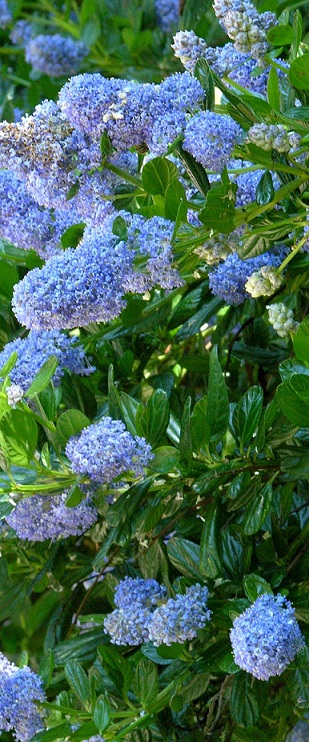|
Throughout western North America we find the Red Stem Ceanothus, a deciduous
shrub that
grows smaller than the Blueblossom but slightly larger than Snowbrush.
It has white blossoms April through June, fruit in June and July. It's
larger leaves are pleasant but the red stems
that show to great advantage in the winter landscape after the leaves have
fallen are it's most outstanding quality. Blueblossom and Snowbrush leaves are oval-shaped 1 1/2 to 2
1/2 inches long, shiny dark green with serrated edges and 3-veined from the base.
Leaves of the Red Stem variety are larger, grass-green and slightly hairy.
Flowers are borne in dense clusters, very blue up to 3 inches long for C. thrysiflorus and white up to 5 inches long in C. velutinus. Red Stem flowers are
flat clusters approximately 3 inches across and looser than the evergreens. The
fruit of all three species is small 3-lobed filed with tiny dark seeds which
have a hard coat. |
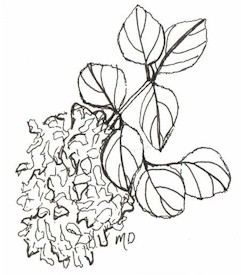 |
This family of shrubs performs a valuable ecological service in fixing
large amounts of nitrogen in the soil. They do this through a symbiotic
association with a bacteria which inhabit their roots. This ability is
currently being studied as a major player in land reclamation after forest
fires.
About.com offers
this bit of info:
Nitrogen in
the soil is the most important element for plant
development. It is required in large amounts and
must be added to the soil to avoid a deficiency.
Nitrogen is a major part of chlorophyll and the
green color of plants. It is responsible for
lush, vigorous growth and the development of a
dense, attractive lawn. Although nitrogen is the
most abundant element in our atmosphere, plants
can't use it until it is naturally processed in
the soil, or added as fertilizer.
Now, most native plant gardeners are
not afficionados of the 'lawn,' but the same dynamics exist
with practically every other plant on the earth. Keeping a
few ceanothus growing in your yard will take care of the
nitrogen requirements your other plants may need. If you
have some squirrels around, they'll help with mixing the
soil in the landscape--less work for the friendly gardener!
|
|
Habitat and Geographic Range: Generally speaking, most evergreen
Ceanothus are not sufficiently
cold-hardy for the high desert temperatures of eastern Oregon. However, they are
perfectly suited for the milder lower elevations in eastern Oregon and the western side of the state. One thing all
varieties agree upon is the drought of summer. They must have well-drained soil:
standing water will quickly give rise to root-rot. We often see them in soil low
in organic matter. In North America, Red Stem is found from the Siskiyou Mountains of northern California
to the southern areas of British Columbia, including Vancouver Island. It's
range reaches to the east
in mountainous sites to western Montana where is has been reported at 2,400
feet. It also occurs in northern Michigan, California to 4,000 feet, Idaho, Minnesota, Montana, Oregon and Washington. Red
Stem ceanothus
is a prominent component of seral brush field communities as well as those of
mixed conifers. |
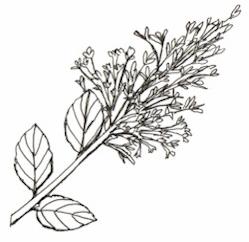 |
|
In mountain ranges, we see it mostly in areas of
Ponderosa pine
(Pinus
ponderosa), mixed conifers and Western Hemlock (Tsuga heterophylla). Common companions are
Ninebark (Physocarpus
malvaceus), Oceanspray (Holodiscus
discolor), Rocky
Mountain Maple (Acer
glabrum), Grand Fir (Abies
grandis), Scouler's Willow (Salix
scouleriana),
Saskatoon (Amelanchier
alnifolia), Western Red Cedar (Thuja
plicata),
Douglas Fir (Pseudotsuga
menziesii), Snowberry (Symphoricarpos
albus),
Thimbleberry (R.
parviflorus), and Bitter Cherry (Prunus
emarginata). In both the Cascade Range and the Rocky Mountains it is found
primarily in the Ponderosa Pine (Pinus
ponderosa) zone and in parts of the mixed
conifer and Western Hemlock zones. |
|
In the forest succession studies, Red Stem Ceanothus/Ninebark groups are
prominent as post-fire structural components. They are associated with early- or mid-seral stages of forest
succession. Red Stem Ceanothus particularly is prominent colonizer after fire or timber harvest. When
the tree canopy becomes denser this shrub is more sparse, often giving way to
Oceanspray and
Chokecherry (Prunus
virginiana) though it is often 15 years before
it recedes to the brush field areas. |
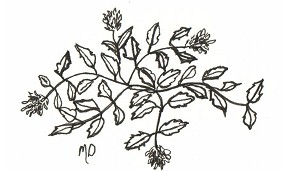 |
Uses of Plant:
Landscape: All 3 of the ceanothus under discussion here are excellent
landscape plants. Their needs are few: good drainage and occasional rain after
they are established. Poor soil is fine with them all, no fertilization
required. |
|
Red Stem Ceanothus is
clearly intolerant of shade, but Snowbrush will tolerate partial shade (although
it does prefer sun) and Blueblossom is much less particular in this regard. All
are excellent both inland and oceanside.
The beautiful clear blue of Blueblossom, white clusters of blooms for
Snowbrush and attractive dark green leaves of both are desirable features. All
bloom abundantly at a young age with fragrant blossoms. Ceanothus sanguineus'
red stem bunches are excellent winter beauty. All these shrubs are well-behaved:
they can be pruned back to limit growth, they allow trimming into rounded or
cushion shapes sheared into hedges, but their natural growth habits are not
overwhelming. Left to assume their full growth naturally, they are full and
pleasant to the eye. |
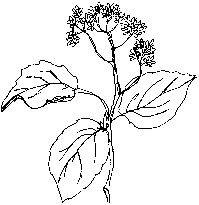 |
Reclamation uses:
Naturally occurring after fires or timber harvest,
Ceanothus
curbs erosion and has the very desirable ability of fixing nitrogen in the soil.
|
| Wildlife habitat: An important food and shelter for many wildlife species,
and browse for white-tail and mule deer. Red Stem is reported to comprise as much
as 1/3 of the winter diet of Rocky Mountain elk. Livestock will also eat Red Stem
as do domestic sheep. Birds such as the rufous-sided towhee, western bluebird,
Nashville warbler and olive-sided flycatcher, and small mammals such as deer
mice, voles and chipmunks find shelter in these shrubs and are fond of the seeds
as are insects. Native bees are attracted to the blossoms.
Native Americans make tea from the leaves and flowers. Some species produce better
tasting tea than others. A red dye can be made from the roots. The stems make
perfect foundations for baskets. The blossoms can be mixed with water to produce
a soap. A native custom among some tribes sees a bride and groom shampooing each
other's hair with this aromatic mixture as part of the wedding ceremony.
Propagation:
Red Stem
Ceanothus develops a deep root system that can aid in soil
stabilization.
This species can be nursery propagated,
and has been successfully planted on logged sites, road cuts, and acid mine
spoils. |
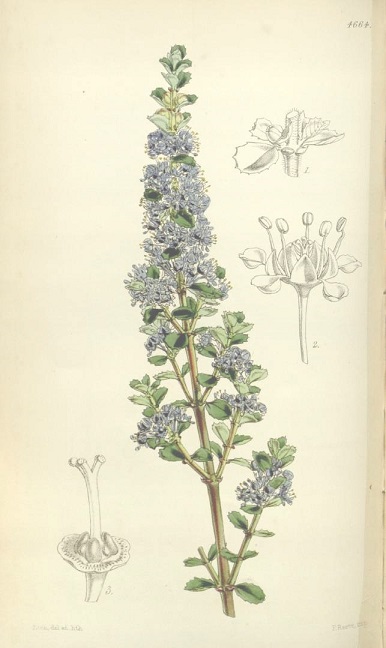 |
|
If a large area is to be seeded, the seeds must be heat-treated and sown immediately during late fall
rains just before snowfall. The seeds will then stratify naturally in the soil over winter
and most will germinate the next spring, although small numbers may continue to
sprout for up to 8 years. Sprouts can produce seed by 3 - 6 years of age. |
Cuttings and seedlings alike are susceptible to stem rot or "damping off," cold
winter temperatures, drought, fungus, heavy competition and herbivores. Those
that are still living by the second year will normally survive.
Culture:
Ceanothus perform best with little summer watering. Too much water generally
causes root rots except in stages of active growth. Late in the season, withhold
water to allow the plants to harden off before winter sets in. Until
established, deep watering is required. After the plants are comfortable in
their surrounds, minimal watering is recommended.
Do not be mislead into thinking lots of water and fertilizer will make a
better plant. In the case of Ceanothus, water deeply until the plant is firmly
rooted in the well-drained soil and then water sparingly, if at all, after the
establishment period is over. Fertilizer is not welcome to Ceanothus and may
actually shorten their life-span. |
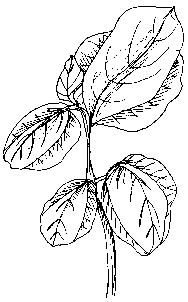 |
|
Red Stem prefers full sun as does Snowbrush which will take some shade and
Blueblossom will take more shade.
Pruning can be done at any time, but should be limited by fall as it usually
promotes new growth which may be damaged unless it has time to mature before the
cold season sets in. Of course, pruning after the blooming period is desirable so the
beautiful blossoms and their fragrance can be appreciated.
As an experiment, we planted a 1-gallon Ceanothus thrysiflorus
under a large conifer, watered it deeply 3-4 times during the first year and not
at all since then. It is now in it's third season since planting, quite strong
and sturdy and presented an admirable show of blue blooms this year.
Historical and
Special interest:
The Oregon Garden trials are testing a range of
Ceanothus cultivars, from
small to large shrubs. These will be evaluated by variety for rate of growth,
length and degree of bloom and sensitivity to cold. The goal is to find which
varieties will fare best in Oregon's Willamette Valley.
Origin of
botanical name, original discovery info, etc.:
Common names are self-explanatory. Also known as New Jersey
tea.
A special thanks to the USDA Forest Service Fire Effects Information
website, located at
http://www.fs.fed.us/database/feis/about.html
|
|
Species Information For This Genus
Click on links below for
photos and details of each plant. |
|
As yet, not all northwest native
ceanothus are covered in this website, though that may be done some time in the
future. For now, we have information about only six of our northwest native
ceanothus. |
|
Ceanothus cuneatus var. cuneatus (Buck Brush)
A spreading evergreen shrub, rounded to sprawling, reaching 9 - 10' tall at
maturity. The evergreen leaves are stiff and somewhat tough and may be slightly
toothed along the edges. Abundant white flowers, sometimes tinted blue or
lavender. Fruit is a round capsule with horns. Hybridizes easily with similar
species, producing varied forms.
|
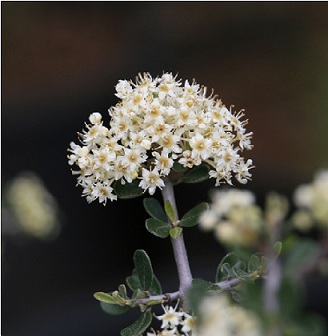 |
|
Ceanothus integerrimus (Deerbrush, Mountain Lilac)
A deciduous shrub 3 - 13' tall openly branched. Drought-tolerant. The
light green leaves are glossy, 1-3" long, ovate. Flowers are white or blue
or (rarely) pink. Fruit is a sticky capsule that ejects seed when split.
Photo credit: Franz Xaver |
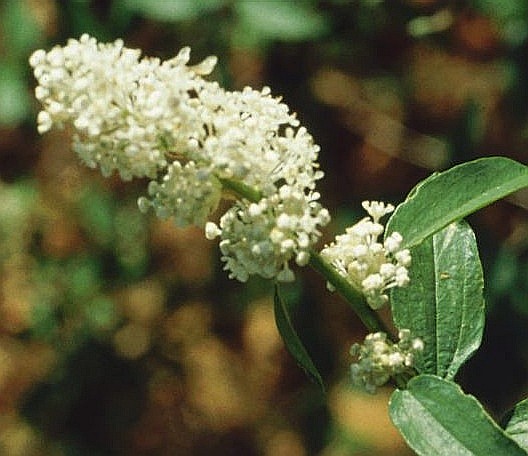 |
|
Ceanothus prostratus (Mahala Mat)
This evergreen shrub is very low growing, forming a mat up to 8 feet wide.
Small leaves are tough and leathery with sharp teeth along the edges.
Flowers are small clusters of deep blue to lavendar tight to the stems.
Very nice groundcover. |
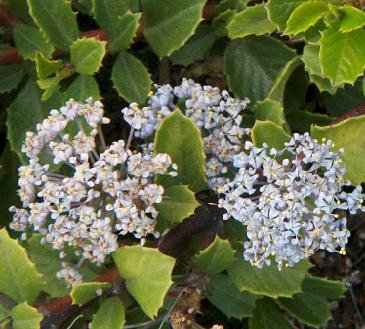 |
|
Ceanothus
sanguineus (Red Stem Ceanothus)
A deciduous shrub growing to 9
feet at maturity. Native to western North America from British Columbia
to Montana to far northern California; it is also known from Michigan. As do
some other Ceanothus, this one requires fire for reproduction and
proliferation. The seeds become active with heat and the plants quickly
fill in spaces left by wildfires. Clusters of white flowers are about 4
inches long. An important food source for elk and also browsed by
livestock. Seeds are also enjoyed by many kinds of animals. |
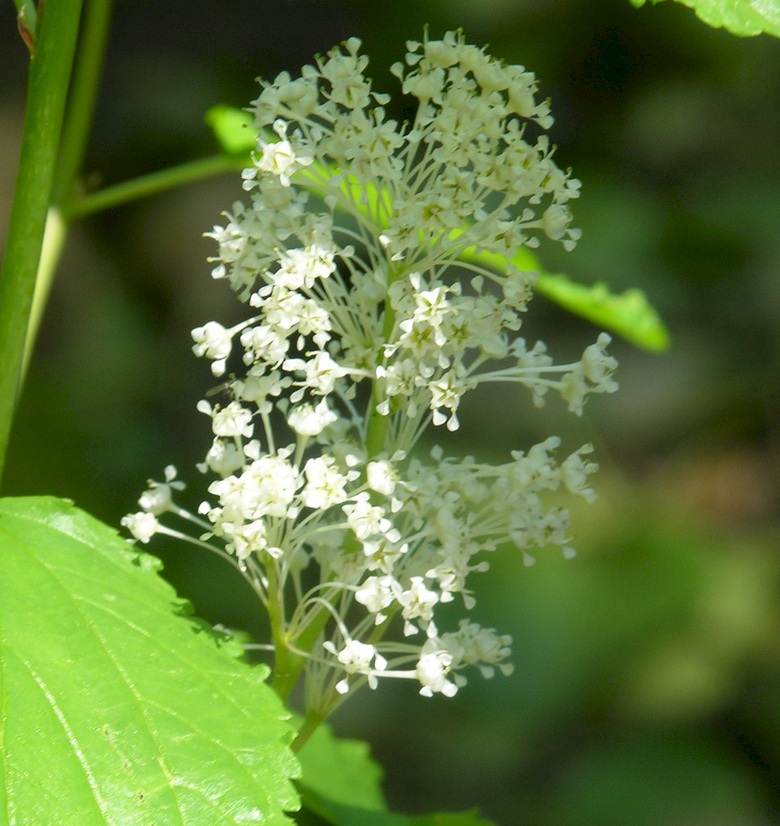 |
|
Ceanothus
thyrsiflorus (Blueblossom, California Lilac) The queen of wild evergreen lilacs, Blueblossom
reigns with grace and majesty from southwestern Oregon to southern
California (USDA zones 8-10). When mature, it
often reaches 20 feet tall in its native habitat of chaparral. Quite
tolerant of shade, the blue flowers are outstanding. They can also vary
from pale blue to white and many shades of blue. |
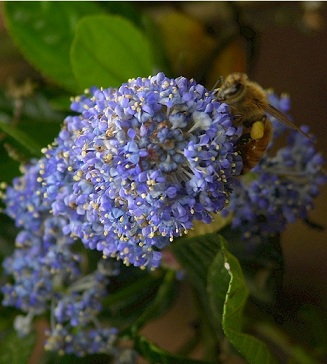 |
|
Ceanothus
velutinus (Snowbrush)
A medium-tall evergreen shrub from 9-10 to 13 feet when fully grown.
It is a colonizing plant which tangles together to make an almost
impenetrable thicket. With its aromatic leaves and plentiful long
clusters of white flowers, this is an excellent choice for tall hedges.
The three-lobed seed pods snap open and shoot the three seeds into the
soil where they can lie in wait for centuries until a wildfire comes
along to scarify them. Consequently, there is little bother by
volunteers. However, the seeds can be caught and scarified manually to
produce new plants. |
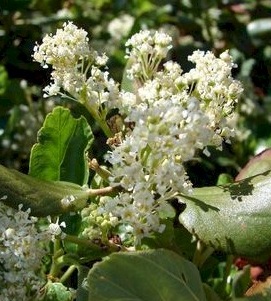 |

